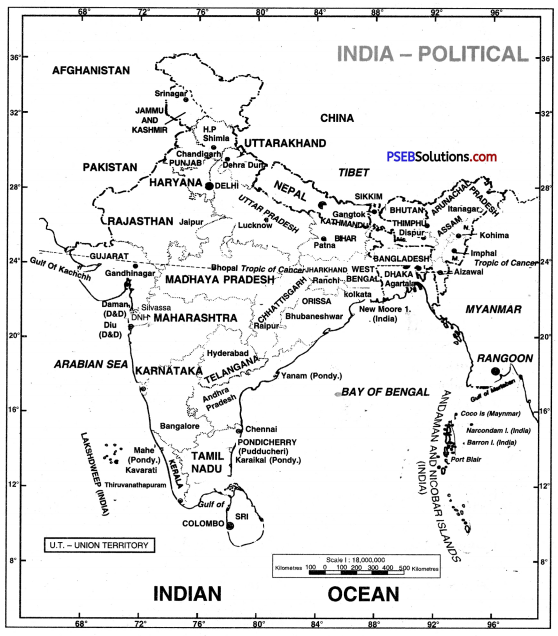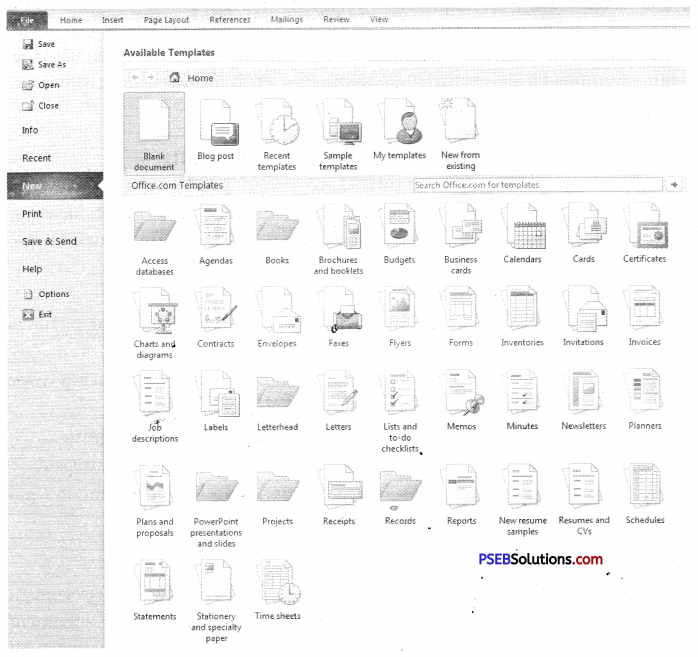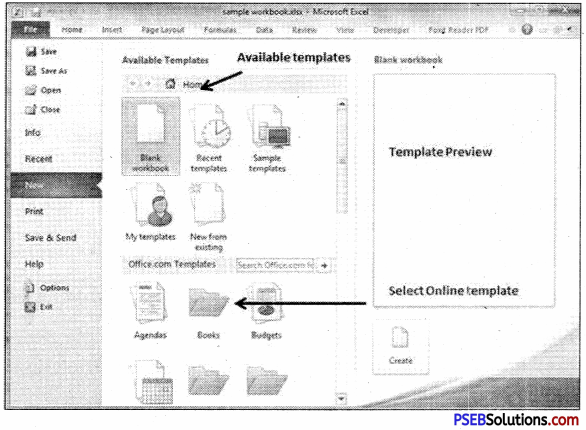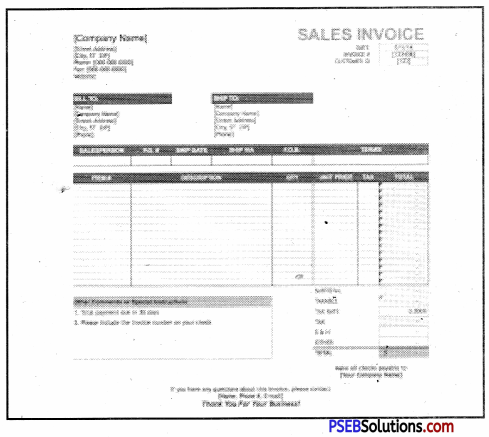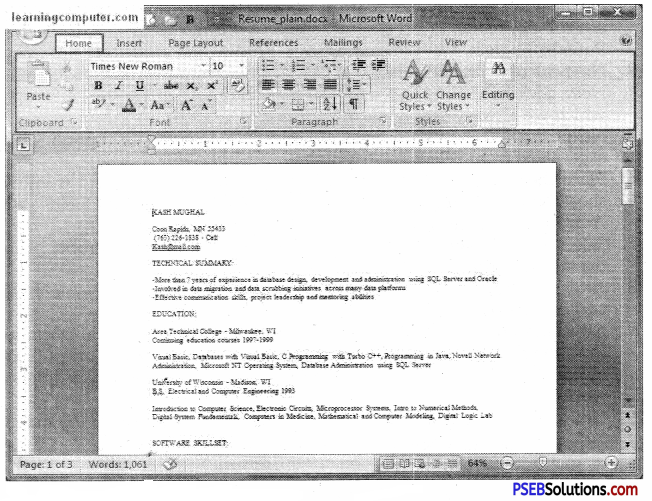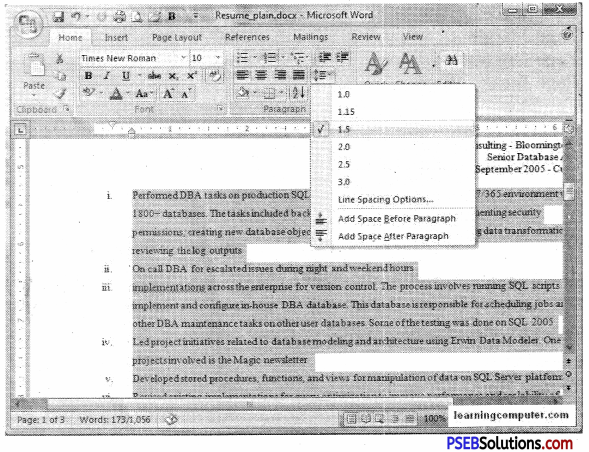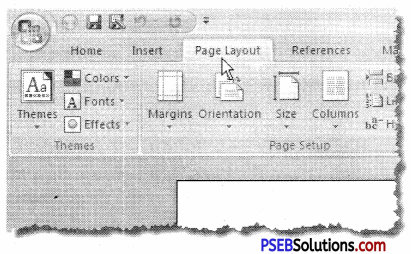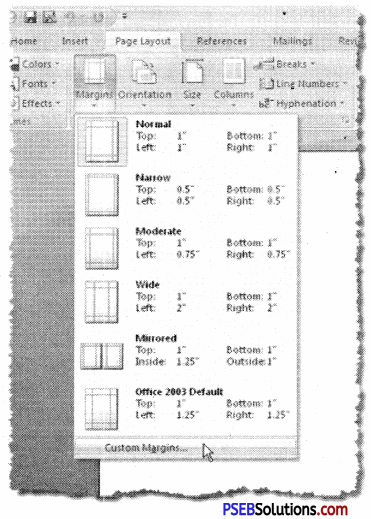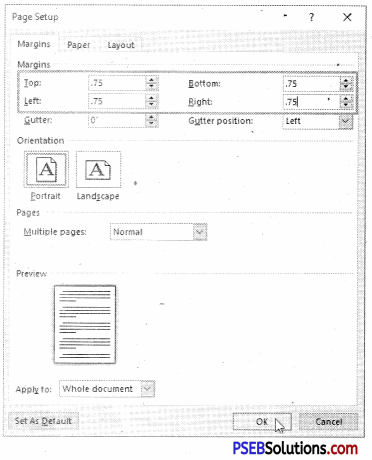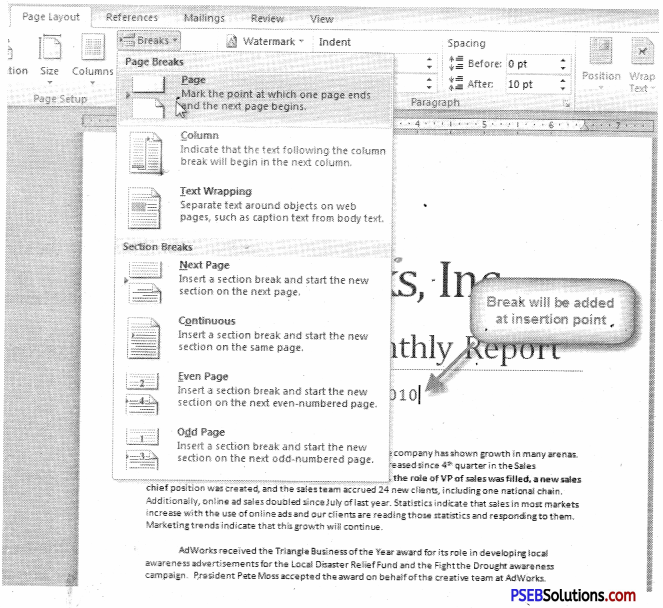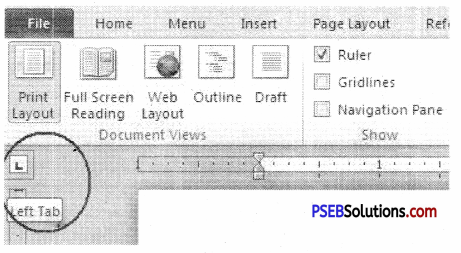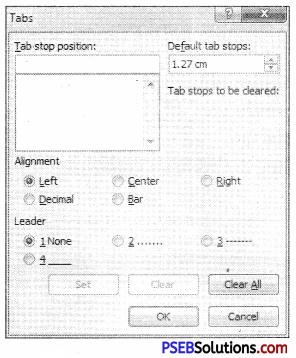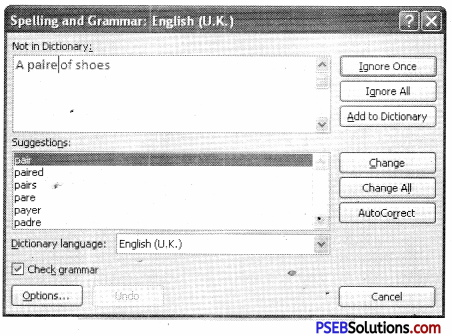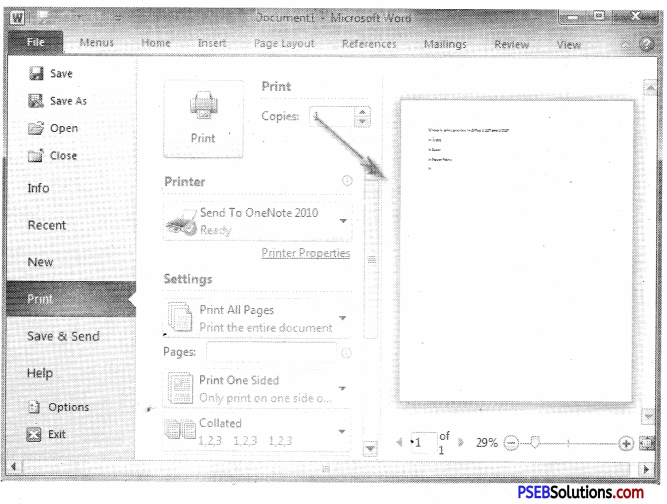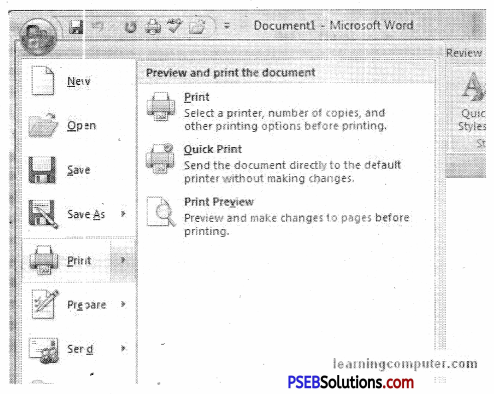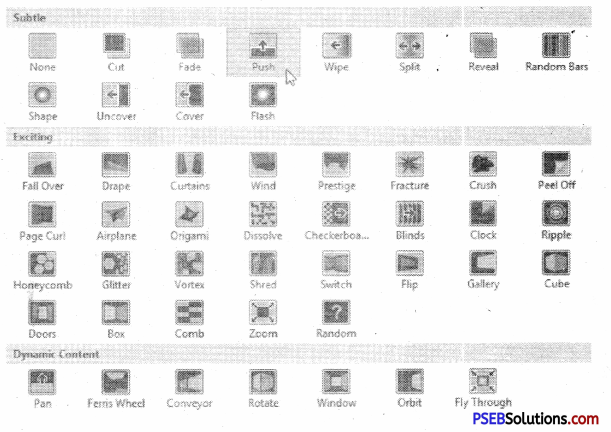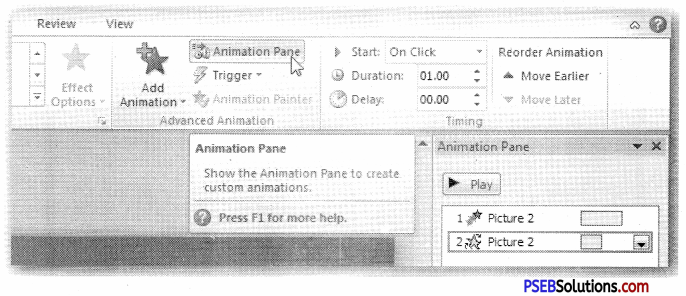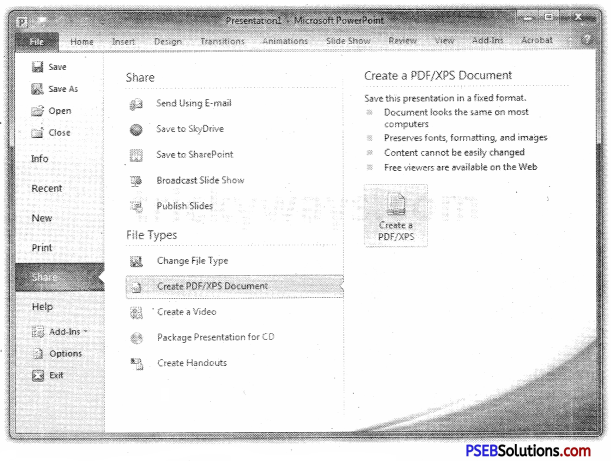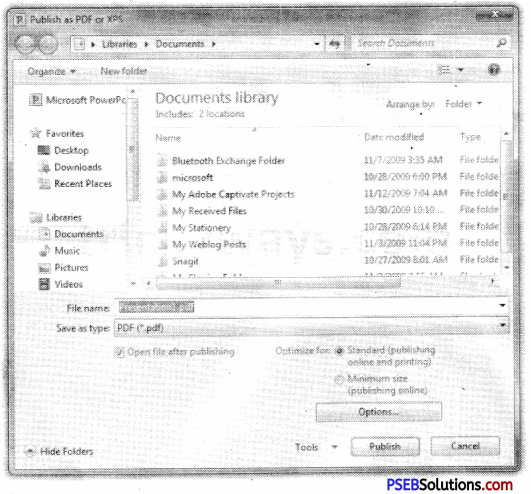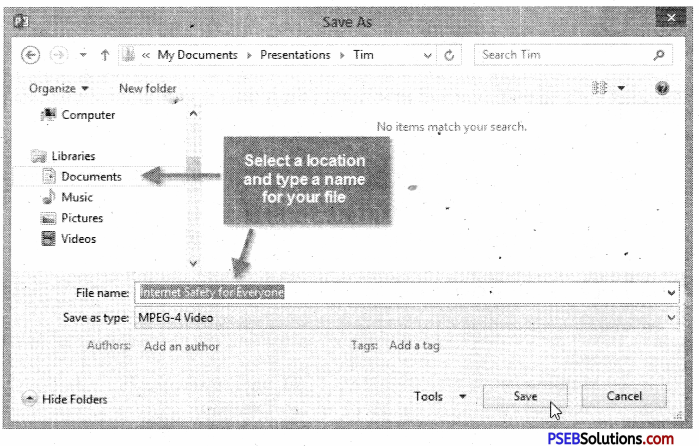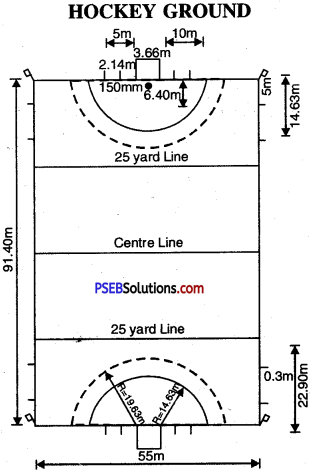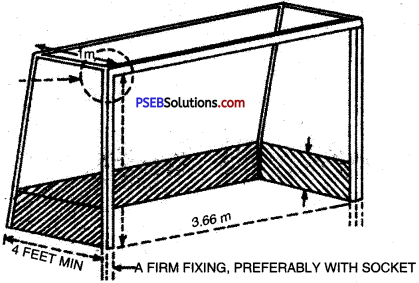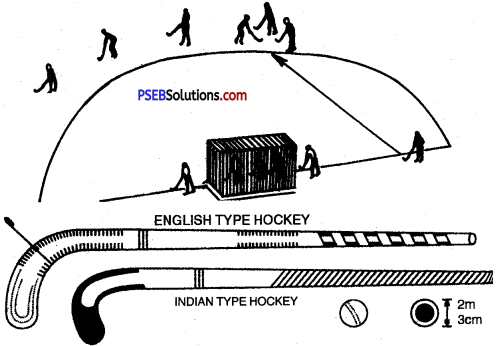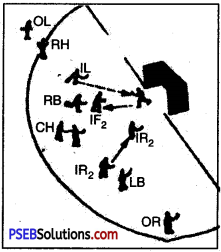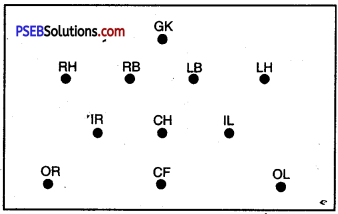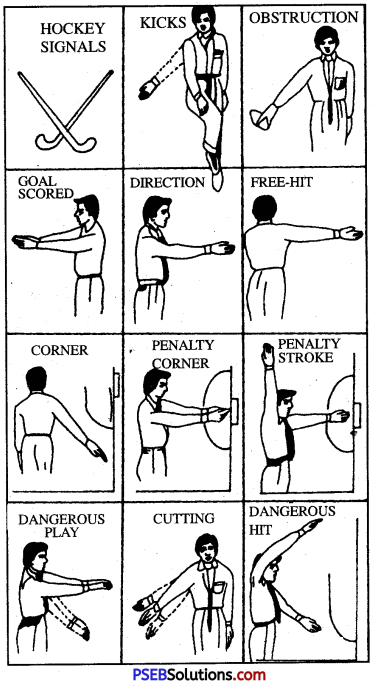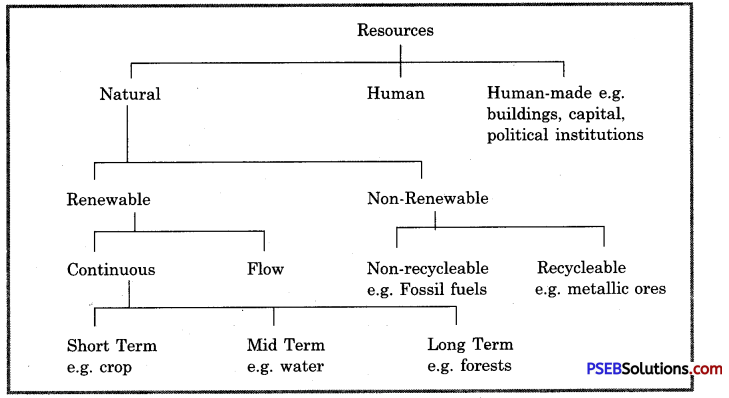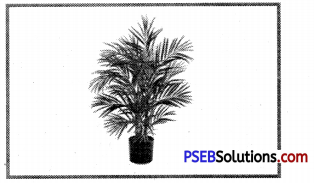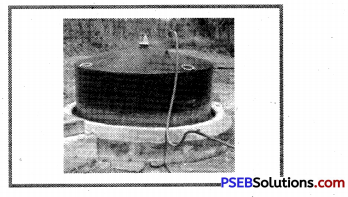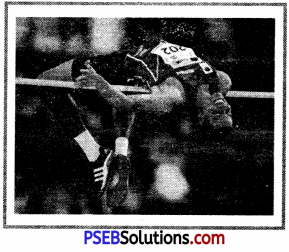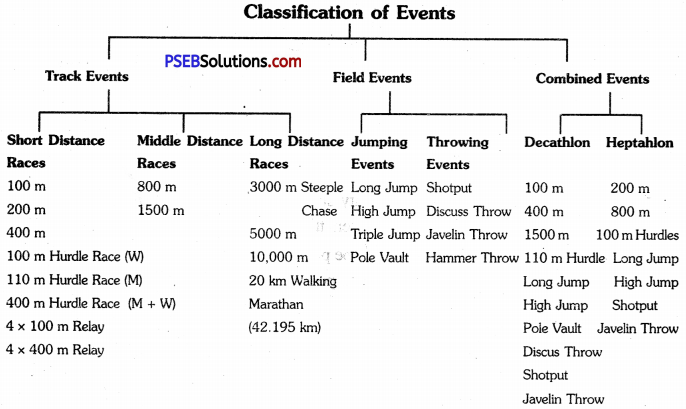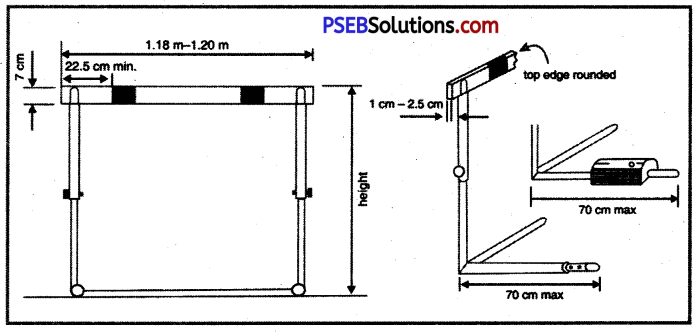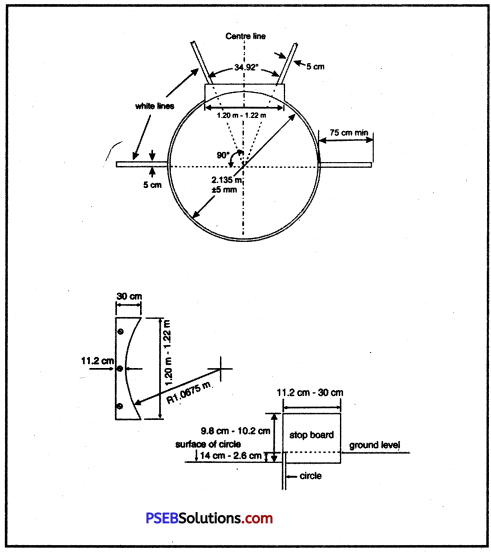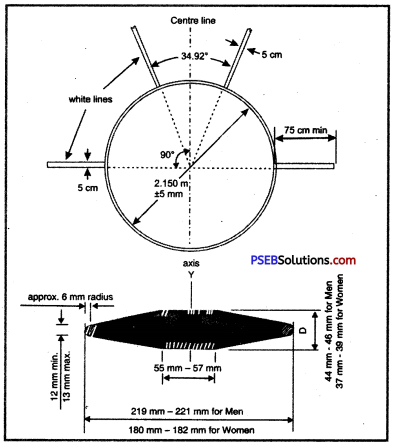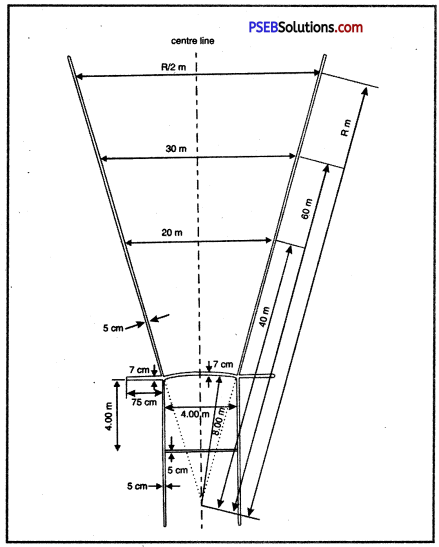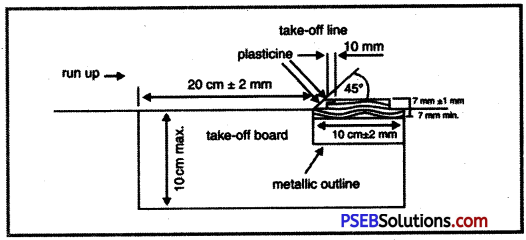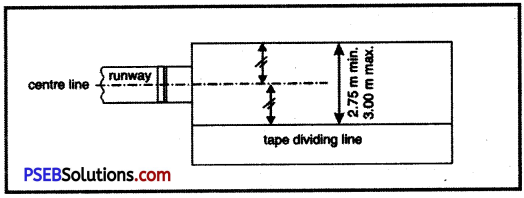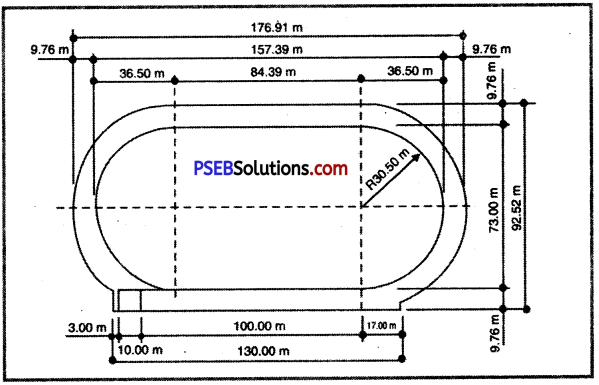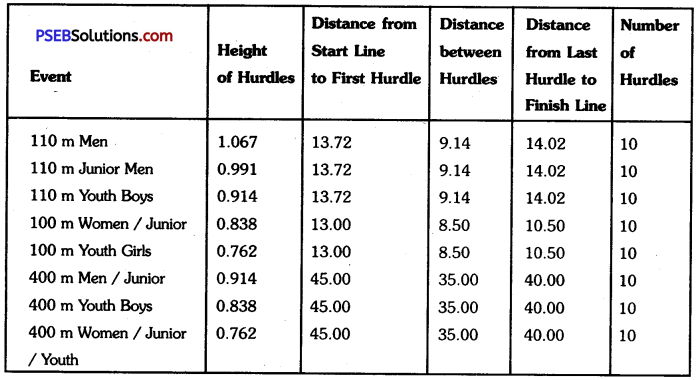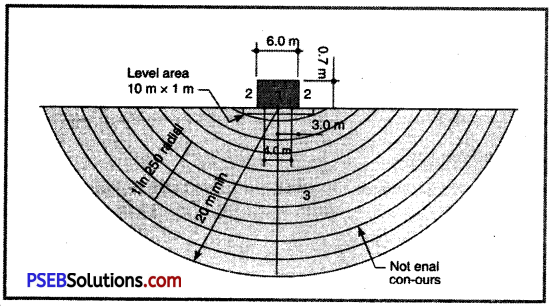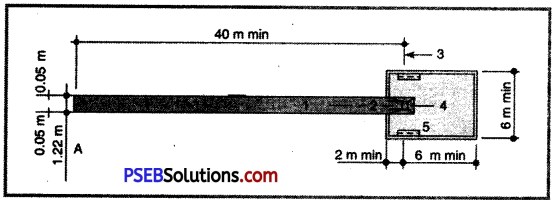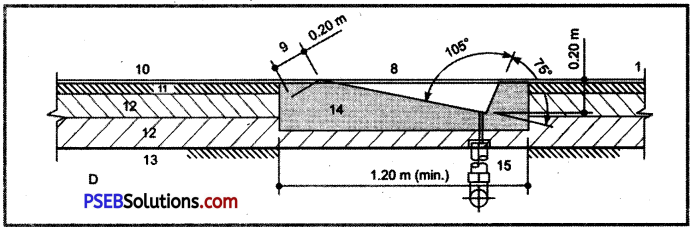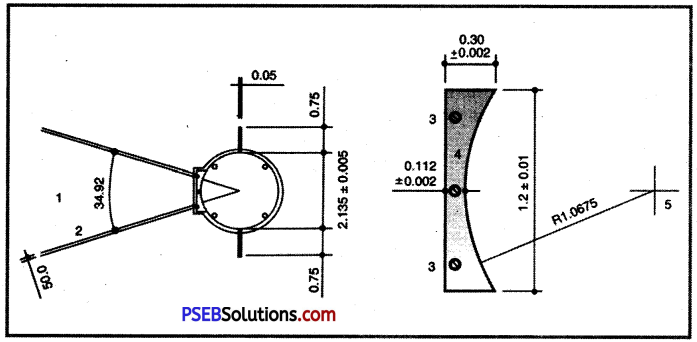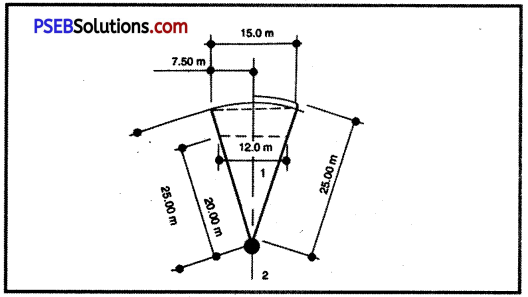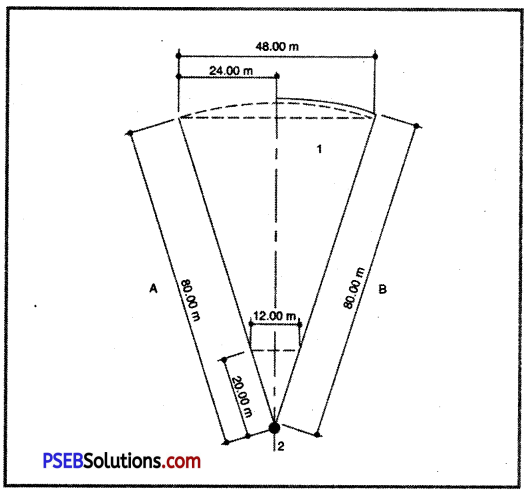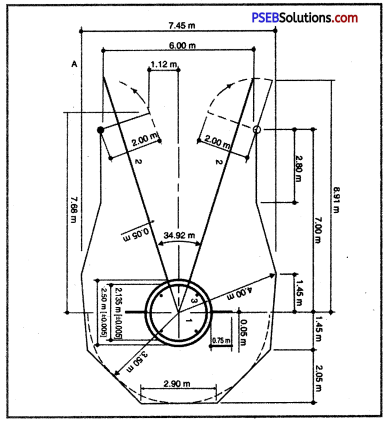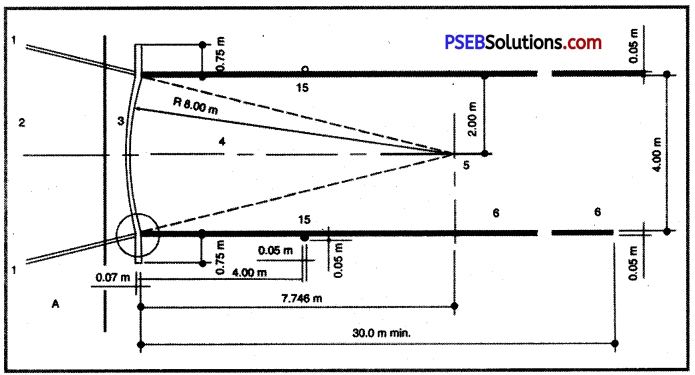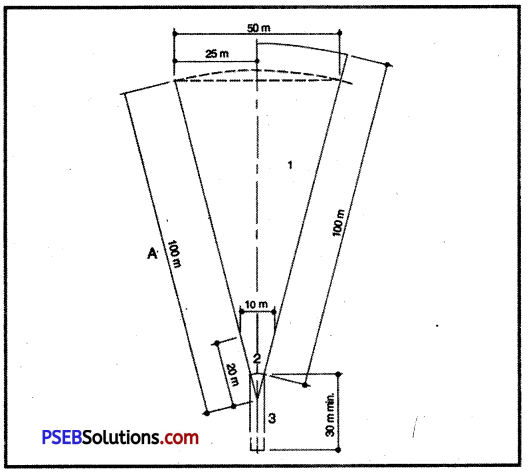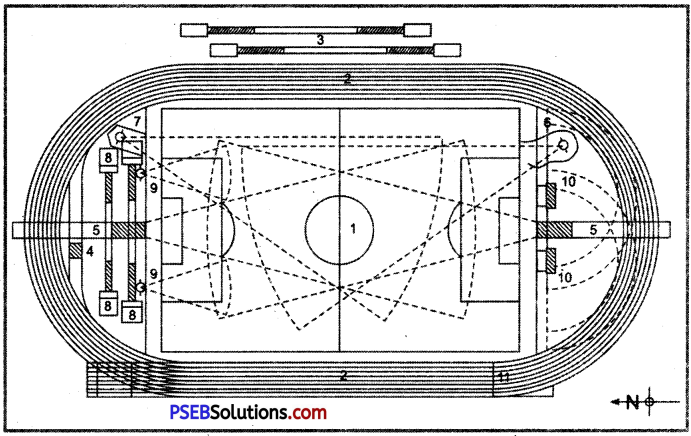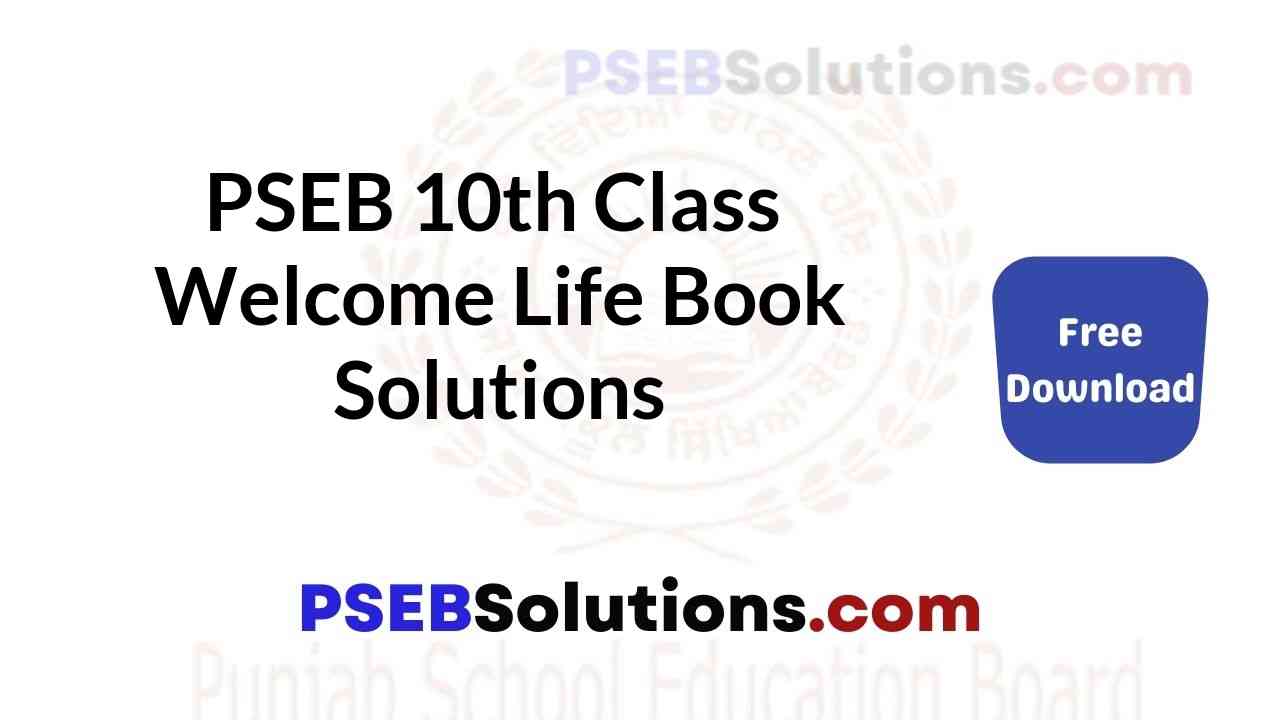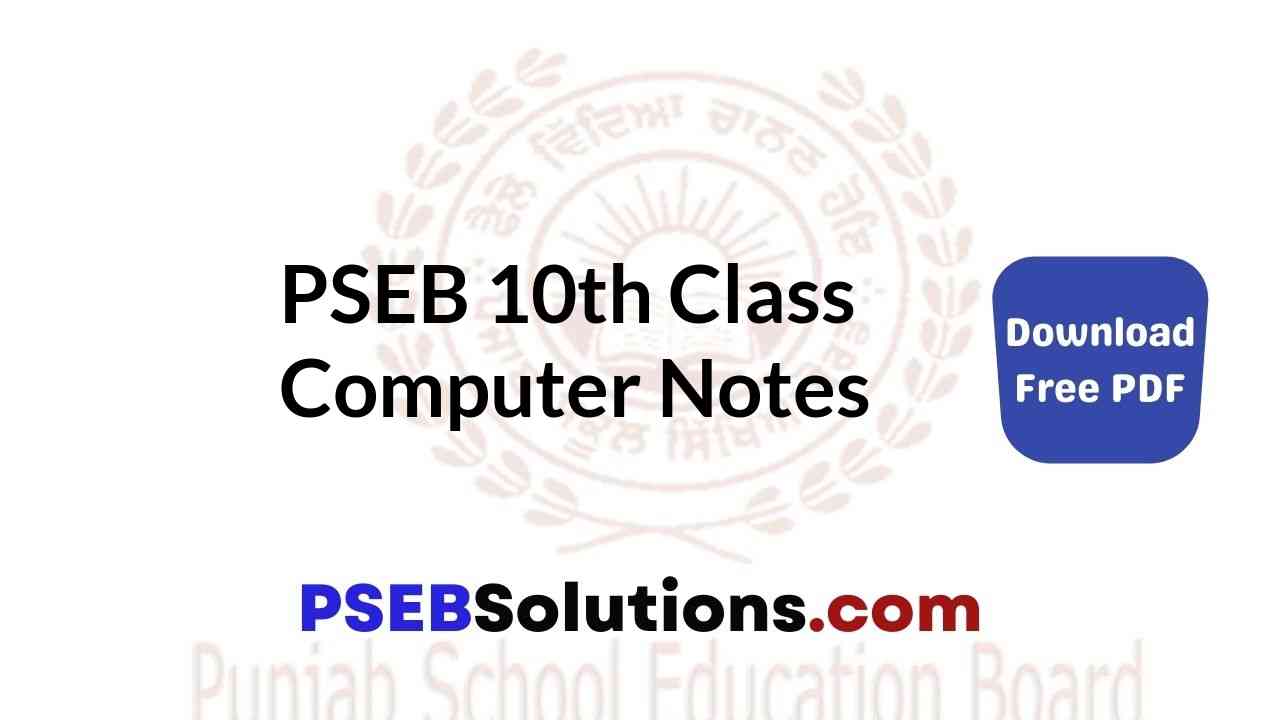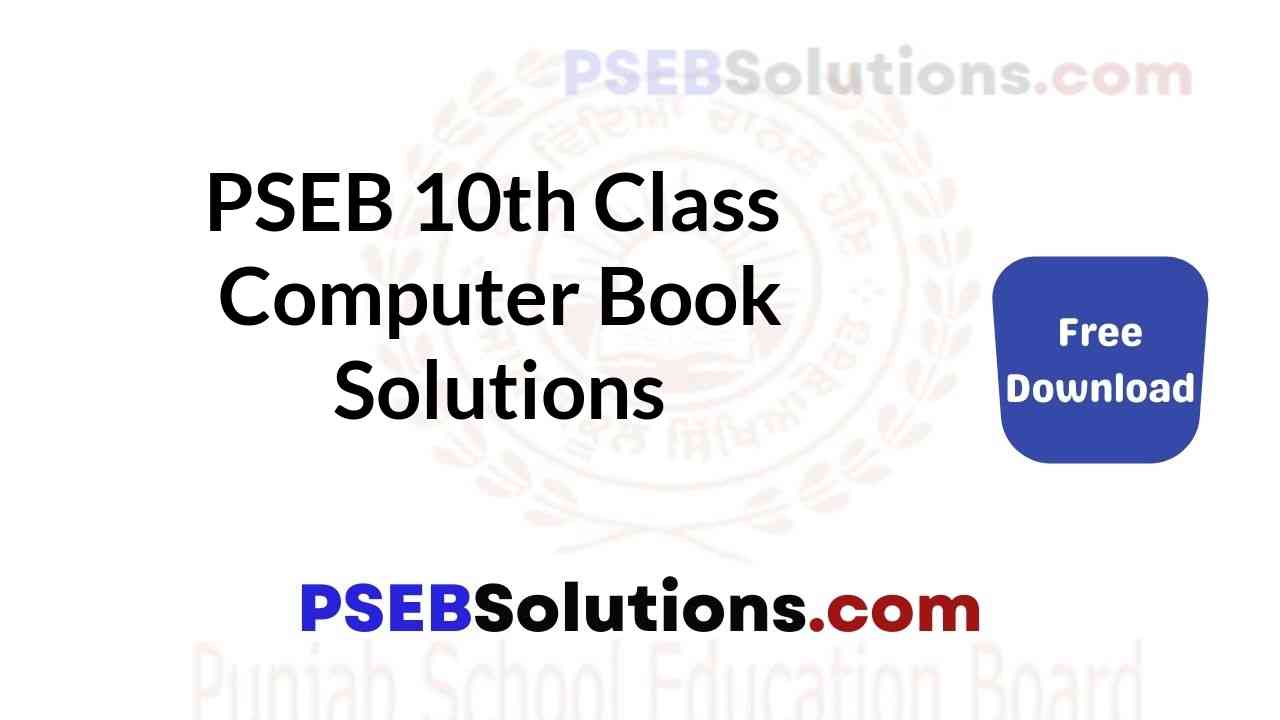Punjab State Board PSEB 10th Class Physical Education Book Solutions Practical Questions and Answers.
PSEB 10th Class Physical Education Practical Questions and Answers
Hockey
Question 1.
How does the game of hockey start?
Answer:
The game of hockey starts when a player passes over the ball under certain rules to another player of his side from the centre line.
Question 2.
How many players are there in a hockey team?
Answer:
There are 16 players in the game of hockey. Eleven of these players play the game while 5 players are substitutes.
![]()
Question 3.
How many players in the game of hockey can be replaced?
Answer:
Five players can be replaced in this game.
Question 4.
How much time is fixed for this game and how much extra time is given in case of a draw?
Answer:
The time allowed in the game of hockey is 35-5-35.
Golden Goal Rule:
If both the teams remain equal during the allotted time the extra time given is 7 \(\frac{1}{2}\), 7 \(\frac{1}{2}\) minutes . As soon as the goal is scored during this time the game ends. The team scoring the goal is declared the winner. Even then if a goal is not scored both the teams are given 5, 5, penalty strokes up to the time the match is decided.
Question 5.
Tell the length and breadth of hockey ground?
Answer:
The length of a hockey ground is 100 yards 91.25 m and its breadth is 60.55m yards.
![]()
Question 6.
Tell the weight and diameter of a hockey ball?
Answer:
The weight of a hockey ball is 5 \(\frac{1}{2}\) ounce and its diameter is 9 \(\frac{1}{2}\) inches.
Question 7.
Tell about the number of people involved in the administration of a hockey game?
Answer:
Following administrators help to organise a hockey match:
- Referee – 1
- Empire – 2
- Linemen – 2
Question 8.
Give the positions of the players in a hockey game?
Answer:
There are 11 players in a hockey game:
- Goal keeper.
- Right full back.
- Left full back.
- Right half back.
- Centre halfback.
- Left half back.
- Right-out forward.
- Right-in forward.
- Centre forward.
- Left in forward.
- Left out forward.
![]()
Question 9.
Tell the length and height of the goal post?
Answer:
A goal post is 4 yards in length and 7 feet in height
Question 10.
What is the length and height of a goal board?
Answer:
Goal board is 4 yards long and not higher than 18 inches.
Question 11.
What is the weight of a hockey-stick?
Answer:
The weight of a hockey stick for men is 28 ounce and 23 ounce for women.
Question 12.
What type of uniform should be there for a hockey player?
Answer:
The uniform for a hockey player includes a shirt, a nicker, socks, shoes. A goal-keeper needs pads and gloves also.
![]()
Question 13.
What is the striking diameter for the game of hockey?
Answer:
In front of each goal-post there is a white line which is 4 yards, 3.66 m long and 3 inches wide. It is drawn parallel to the goal post at a distance of 16 yards. It goes to the diameter of the breadth of the 3 inch line. Its centre will be the goal post. The striking diameter is the outer corners of the 16 yard line and the centre of the goal line including the lines.
Question 14.
Tell the distance of the penalty stroke?
Answer:
Penalty stroke is hit from a distance of 8 yards from the goal post.
Question 15.
Is there stick in the game of hockey?
Answer:
Now a days there is no stick in the game of hockey. Even if the hockey is raised above the shoulder it is not treated as a foul provided the hit is not dangerous.
Football
Question 1.
Tell the length and breadth of a football ground?
Answer:
The length of a football ground should not be more than 130 yards and less than 100 yards. Its breadth should not be more than 100 yards and less than 50 yards.
Question 2.
How many players are there in a football game also tell their position in the game?
Answer:
In a football game there are 16 players out of which 11 play the game and 5 are the substitutes.
Position. Goal keeper = 1, Full-back = 2, Half = 3, Forward = 5.
![]()
Question 3.
Tell the time for a football game?
Answer:
The time for a football game is 45-5-45 minutes.
Question 4.
What is the weight of a football and what is its diameter?
Answer:
The weight of a football is from 14 ounce to 16 ounce arid its diameter is 27 to 28 inches.
Question 5.
Tell the breadth of the lines of a football ground?
Answer:
All the lines of a football ground are 5 centimetre wide.
![]()
Question 6.
What is the weight of air in a football?
Answer:
The weight of air in a football is 0.6007 or 9.01505 pound per square inch.
Question 7.
How does the game of football start?
Answer:
The game of football starts with a pass of ball.
Question 8.
Tell the length and height of the goal posts?
Answer:
The goal posts are 8 yards in length and 8 feet in breadth.
![]()
Question 9.
Tell the distance of a penalty kick?
Answer:
Penalty kick takes place from a distance of 16 yards.
Question 10.
When does a goal take place?
Answer:
When the ball crosses the line in between the goal posts the goal takes place.
Question 11.
At what distance should the players of the opposite team stand when the jkick takes place?
Answer:
This distance should be 10 yards.
![]()
Question 12.
What is throw-in?
Answer:
When the ball goes out of the ground and the player of the opposite team throws the ball in from that very placg it is called throw-in.
Question 13.
How many flags are put in a football game?
Answer:
Six flags are fixed in a football game. Four of them are fixed at the corners of the ground and two are fixed at the end of the centre line at a distance of one yard each.
Question 14.
Tell four fouls in a football game?
Answer:
Following are the four main fouls in a football game:
- To hit the player of the opposite team.
- To touch the ball with hands.
- To push a player.
- To attack the opposite player from behind.
![]()
Question 15.
Give the number of the administrators in the football game?
Answer:
Referee = 1, Goal Judge = 2, Lineman = 2.
Question 16.
Can there be a penalty corner foul outside the D also?
Answer:
Penalty corner can be awarded outside the D also if the attacking player is stopped in a dangerous way.
Question 17.
When is the penalty-stroke awarded?
Answer:
When the players of the defending team deliberately catch the ball or keep it under foot the penalty stroke is given.
Volleyball
Question 1.
How many players are there in a volleyball game?
Answer:
There are 12 players in a volleyball game out of which six are the players and six are the substitutes.
Question 2.
How many players in a volleyball game can be substituted?
Answer:
Six players can be substituted. All the six players can be substituted.
![]()
Question 3.
Tell the length and breadth of a volleyball court?
Answer:
A volleyball court is 18 metres long and 9 metres wide.
Question 4.
Tell the length and width of a volleyball net?
Answer:
The length of a volleyball net is 9 metre and its breadth is one metre.
Question 5.
Tell the height of a volleyball net?
Answer:
The height of a volleyball net for boys is 2.43 metres and for girls it is 2.24 metres.
![]()
Question 6.
What is the weight of air in a volleyball?
Answer:
The weight of air in a volleyball should be 0.48 kg to 0.52 Kg.
Question 7.
How does the rotation take place in a volleyball game?
Answer:
In a volleyball game six players play from each side. Three out of them are in front of the attacking line and three are behind it. The first one takes the service. At the time of service 4, 3, 2 are before the attack line and 5, 6, 1 are behind them.
Question 8.
What is the position of players in a volleyball game?
Answer:
Following is the position of the players in a volleyball game:
4 3 2
5 6 1
![]()
Question 9.
Give the number of the administrators in a volleyball game?
Answer:
1. Referee = 1, 2,
Umpires = 1, 3
Linemen = 2.
Question 10.
How is a match decided in a volleyball game?
Answer:
The team that wins two sets out of the three sets is declared the winner. Five sets take place in national and international games. The team that wins three out of five is declared the winner.
Question 11.
For how many times the time-out can be availed in a volleyball game and what is the time span of a time out?
Answer:
Two time-out can be availed in one set. The time out is for 30 seconds only.
![]()
Question 12.
Give five main fouls in a volleyball game?
Answer:
Following are the five main fouls in a volleyball game:
- To catch the ball when the game is going on.
- To touch the centre-line.
- To touch the line while taking the service.
- To touch the ball for more than three times.
- When the player touches the ball twice continuously.
Question 13.
What is the score fixed for a volleyball game?
Answer:
There are 15 points in a volleyball game. If both the teams score 14-14 points each it is obligatory for the game to be played upto 16-14, 17-15, 19-17.
Question 14.
Is a rope put at the lower side of the net?
Answer:
No rope is put at the lower side of the net.
![]()
Question 15.
Can the opposite team block a service?
Answer:
If the ball comes just near the net, the opposite team can block the service.
kho-kho
Question 1.
How many players are there in a Kho-Kho game?
Answer:
There are twelve players in a Kho-Kho game out of which 9 are the players and three are the substitutes.
Question 2.
Tell the length and breadth of a Kho-Kho ground?
Answer:
A Kho-Kho ground is 29 metres in length and 16 metres in breadth.
![]()
Question 3.
Who is called a chaser and who is a runner in a Kho- Kho game?
Answer:
The players who sit are called the chasers and those who run are called the runners.
Question 4.
How many innings are there in a Kho-Kho match?
Answer:
There are two innings in a Kho-Kho match.
Question 5.
What is the time for a Kho-Kho match?
Answer:
The time for a Kho-Kho match is 9-5-9,10 rest, 9, 5,9 minutes second innings.
![]()
Question 6.
How does the match start?
Answer:
Toss takes place before the beginning of the match. The team that wins the toss decides to become chaser or runner.
Question 7.
How many points are scored when a runner gets out?
Answer:
One point is scored when a runner gets out.
Question 8.
How is the match decided?
Answer:
The team that scores more points is declared the winner.
![]()
Question 9.
How many squares are there in a Kho-Kho game and what is their size?
Answer:
There are 8 squares measuring 30 c.m. x 30 c.m in a Kho- Kho game.
Question 10.
Is there a playing lobby in Kho-Kho? Tell its breadth?
Answer:
There is a playing-lobby in Kho-Kho and its breadth is 3 metres.
Question 11.
Tell the length and diameter of a Kho-Kho pole?
Answer:
The length of Kho-Kho pole is 1.22 metres and its diameter in 20 cm.
![]()
Question 12.
What is the distance between the Kho-Kho poles?
Answer:
The distance between the Kho-Kho poles is 24.40 metres.
Question 13.
What is the total number of the administrators of a Kho-Kho game?
Answer:
Two umpires, One referee, One time keeper, One scorer.
Question 14.
When is a player considered ‘out’ in Kho-Kho?
Answer:
When the chaser touches the runner or the runner goes out of the ground he is considered to be ‘out’.
![]()
Question 15.
Name five main fouls in Kho-Kho?
Answer:
The main fouls are given below:
I. To get up before getting the ‘Kho’.
II. To cut the centre line.
III. To turn without touching the pole.
IV. The wrong running by the chaser.
V. The runner goes out of the ground on his own.
Question 16.
What is the situation of a draw in Kho-Kho?
Answer:
If both the teams score equal points another innings is played and another innings is played if the match is yet undecided. If the match remains undecided the whole match is played again.
Kabbadi
Question 1.
Mention the length and breadth of the Kabaddi ground?
Answer:
The length of Kabaddi ground is 12.50 metres and Breadth 10 metres. For junior boys and girls length and breadth is 11 and 8 metres respectively.
Question 2.
Mention the number of players in Kabaddi?
Answer:
There are twelve players in Kabaddi game. Out of them seven players actually play and five are substitutes.
![]()
Question 3.
What is the time duration of the game of Kabaddi?
Answer:
The duration of Kabaddi game is 20-5-20 and for junior boys and girls is 15-5-15.
Question 4.
How many scores does Lona have?
Answer:
Lona has two extra points.
Question 5.
When is a player considered to be out?
Answer:
A player who goes out of the boundary during the play shall be considered ‘out’. If an opponent goes out of the boundry and catches the raider, the raider shall not be considered ‘out’ but all the players catching shall be ‘out’.
![]()
Question 6.
How many time-outs can be taken in Kabaddi?
Answer:
Two time-outs can be taken in Kabaddi. The duration of each time out is of 30 seconds.
Question 7.
How is the game of Kabaddi Match decided?
Answer:
Any team which gets more points shall be winner. In case of draw 5 extra minutes will be given until the match is decided.
Question 8.
Mention the number of officials conducting the game of Kabaddi?
Answer:
Officials in Kabaddi are:
- One referee
- Two umpires
- Two lines-men
- One scorer.
![]()
Question 9.
Describe the main fouls in the Kabaddi game?
Answer:
- To hold the raider with help of leg-scissors.
- Outside coaching is not allowed,
- To catch by hair intentionally is foul.
- To try to stifle a raider by shutting his mouth or throttling him.
- Using violent tackling by one player against the other.
Question 10.
Mention the new amendment in the game of Kabaddi?
Answer:
In the game of kabaddi one metre Bonus line is added from the bonus line.
Question 11.
What do you understand by a Bonus for raider?
Answer:
When a raider comes after having crossed bonus line he gets one point.
Badminton
Question 1.
What is the total number of players in Badminton?
Answer:
There are two types of Badminton game. Singles and Doubles. In singles there are two players out of them one plays the game and one is a substitute. In doubles there are three players out of them two play and one is a substitute.
![]()
Question 2.
Mention the length and breadth of the badminton court?
Answer:
Badminton is of two types, Singles and Doubles, For singles the length and beadth is 44′ × 17′. For doubles the length and breadth is 44′ × 20′.
Question 3.
How does the game of badminton start?
Answer:
The two teams shall toss before the play starts. The toss winning team shall have the option of:
(I) Serving First
(II) Choosing Sides.
Question 4.
How many points does the game of Badminton have?
Answer:
Men’s doubles and singles games consist of 7.
![]()
Question 5.
In how many parts the Badminton court can be divided?
Answer:
We can divide Badminton court into two parts. Right court and left court.
Question 6.
Mention the length and breadth of the side gallery of the Badmintion Court?
Answer:
The side and back gallery shall be of 2\(\frac{1}{2}\), and 1\(\frac{1}{2}\), respectively.
Question 7.
Mention the weight of the shuttle?
Answer:
The weight of the shuttle is from 73 to 85 grams.
![]()
Question 8.
Discuss the main rules of the doubles game of Badminton?
Answer:
Doubles:
In the game, there are two players on each side. After having been decided which side is to deliver the service first, the player in the right hand service court of that side shall start the game. He shall serve to the opposing player in the right service court. This matter is decided by the toss winners, and the other matters by the losing one. It is decided before hand whether the game shall have 15 points or 21.
If the opponent returns the shuttle before it touches the ground to the player who started the game, he shall again return it to the latter. In this way, the play shall continue until the foul is made or the shuttle falls down on the ground. In case the service is not returned or the foul is made by the opposing side, the player doing the service shall score one point.
The members of the team delivering the service shall change their service court. Now the player doing the service shall be in the left hand service court and shall serve to the player of the opposing team in the left hand service court. In the beginning of each game, each team shall deliver the service from the right hand service court.
Question 9.
Write the main rules of the single game of Badminton?
Answer:
Singles:
All the above-mentioned rules shall be applicable to singles games but
(i) the player serves from, and receives service in his respective right hand service court. When the player who serves is at 0 or there is an even number of points in the game, the service is always deliverd from the right hand service court. In case of odd numbers, the service is delivered from the left hand service court.
(ii) Both the players change service courts after each has scored 1 point.
(iii) The ladies single game consists of 11 points. When the score is 9-all, the player who first reaches 9 can set the game to 3 points. In case of the score is 10-all, the game is set to 2 points.
![]()
Question 10.
Describe the main Faults of the game of Badminton?
Answer:
Faults:
In case a fault is committed by a player of the playing side, the player who delivers the service shall be “out”. If the fault is committed by an opponent, the playing side gets one point. It shall be considered a fault:
(a) When the struck or served shuttle is higher than the server’s waist or it is struck by the shaft of the racket higher than the server’s hand holding the racket.
(b) When in serving, the shuttle falls into the wrong service court or falls short of the short service line or beyond the long service line or outside the side boundary line.
(c) When serving, the player’s feet are not in the service court.
(d) When before or during service any player intentionally obstructs his opponents.
(e) When in service, the shuttle falls outside the boundary of the court, passes through under the net, fails to pass the net, or touches the person or dress of a player.
(f) If the shuttle is struck before it crosses the striker side of the net.
(g) When the shuttle is in play, a player touches the net or its supports with his body, racket or dress.
(h) When the shuttle is held on the racket, a player strikes it twice in succession or it is struck twice in succession by the player first and then by his partner.
(i) The opponent shall be reckoned as ready if in play he returns the shuttle or tries to hit it, whether he is in or outside the boundary.
(j) When a player obstructs an opponent.
Wrestling – Free Style And Greeco Roman
Question 1.
Mention the duration of the Wrestling?
Answer:
The duration of Wrestling is 5 minutes.
Question 2.
Describe the length and breadth of the Wrestling Mat?
Answer:
The size of the Wrestling Mat should be 9 × 9 metres. The size of the mat of Olympic and World Championship is 9 × 9 metres.
![]()
Question 3.
How many times can a referee warns a wrestler?
Answer:
If any referee warns a wrestler, thrice wrestler will be considered the loser.
Question 4.
How is the score made in Wrestling?
Answer:
Score
(a) One point,
- To a player who throws a rival on the mat and maintains control over him,
- to that player who rises from beneath and maintains his hold on his opponent,
- to a player who makes a good grasp and does not allow his opponent’s head and shoulder to touch the mat,
- for one precaution the opponent gets one point.
(b) Two Points,
- to that player who keeps good hold on his opponent and maintains his hold on him for some time,
- to that player whose opponent immediately falls or falteringly falls.
(c) Three Points,
- to a player who keeps his opponent in danger (when shoulders make an angle of less than 90° from the mat) for five seconds,
- bridge position for three seconds or fall takes five seconds.
![]()
Question 5.
How is the victory or defeat decided in Wrestling?
Answer:
When there is a difference of one point in the score of the opposite players, the bout ends in a draw. Again, if Tio contestant scores any point, or the points are equal, the match ends iii a draw. If the difference is of more than one point, a player with more points is declared the winner.
Question 6.
Describe the officials who conduct the Wrestling?
Answer:
There are three officials in all types of Wrestling bouts:
- Mat chairman
- Referee
- Judge.
No official can be changed during the bout.
![]()
Question 7.
Discuss the main rules of weighing of the competitors?
Answer:
- Weighing of competitors shall begin two to four hours before the Wrestling competition begins.
- The competitors shall be weighed without clothes. They shall be medically examined by a doctor before they are weighed. The doctor will remove any player suffering from any contagious disease.
- Each contestant can participate in Wrestling with a player belonging to his weight-group.
- The competitors should be in a prefect physical condition. Their nails should be well pared. They shall be checked at the time of medical examination.
- Weighing shall start at beast two hours before the competition and must conclude an hour before the first wrestling bout.
Question 8.
Mention the foul holds in Wrestling?
Answer:
Foul-holds:
The following fouls are taken into consideration:
- Pulling of hair, ears, dress, private organs etc.
- Twisting of fingers, grasping of the throat and other holds which may be life-endangering.
- Holding in such a’ manner as may put the opponents’s life in danger, or may hurt any of his body part, or cause him pain so that the opponent helplessly leaves the bout.
- Treading on the feet of the rival.
- Touching the face of the opponent (from the eye-brows to the chin)
- Grasping the opponent by throat.
- Lifting the rival when he is in bridge position, and then throwing him on the mat.
- Breaking the bridge by giving a push from the head.
- Twisting the opponent’s arm at above 90° angle.
- Grasping the opponent’s head with both hands.
- Thrusting the elbow or knee into the abdomen or stomach of the rival.
- Turning the opponent’s arm to the back and pressing it.
- Grasping the opponent’s head in any manner.
- Applying leg-scissors on the body or head.
- Holding on to the mat.
- Talking to each other and making dangerous assault.
Gymnastics
Question 1.
What type of implements are required for Gymnastics?
Answer:
We need the following implements:
For Men and Boys
- Parallel Bar (compulsory and optional)
- Vaulting Horse compulsory and optional
- Ground Gymnastic compulsory and optional
- Horizontal Bar optional and compulsory.
For Women and Girls
- Beam Balance compulsory and optional
- Ground Gymnastic compulsory and optional
- Vaulting Horse optional.
![]()
Question 2.
How many players take part in Gymnastics?
Answer:
There are eight players in Gymnastics, out of the six players participate in competition and two are substitutes.
Question 3.
How are points awarded in Gymnastics?
Answer:
For each gymnastic exercise, there are points from 0 to 10, and each point is sub-divided into 10 parts. If the panel of the judges is of five members, the minimum and maximum points are not considered, and an average of mid three points is taken. If the panel is composed of three judges, the marks of three are taken for average.
Question 4.
Is the decision of the Jury final?
Answer:
The decision of the Jury is final. Participants cannot protest against their decision.
![]()
Question 5.
If a contestant in Gymnastics is ill, for how long can he be awaited for?
Answer:
If any contestant in Gymnastics falls ill, officials have to wait for him for thirty minutes.
Question 6.
How many players can be taken for team championship?
Answer:
For team championship six best Gymnasts shall be considered.
Swimming
Question 1.
How many types of swimming competitions are there?
Answer:
Following types of swimming competition are held:
For Boys:
- Free style – 100, 200, 400, 800, 1500 m.
- Back Stroke – 100, 200 m.
- Breast Stroke – 100, 200 m.
- Butterfly Stroke – 100 m.
- Relay – 4 × 100 metre free style.
- 4 × 100 metre Medley (Breast, Back, Butterfly, Free Style)
For Girls :
- Free Style – 100, 200 and 400 m.
- Back Stroke – 100 m.
- Breast Stroke – 100 m.
- Butterfly Stroke – 100 m.
- Relay – 4 × 100 metre free style.
- 4 × 100 metre Medley (Breast, Back Stroke)
![]()
Question 2.
How Heats and Finals in swimming competitions are organised?
Answer:
Heats and Finals in Swimming Competitions:
Seeding of Heats and Finals. The heats in all semi-finals and final swimming competitions shall be seeded as follows:
(1) Trial Hit
(1) The name, the order of time and the competitive time of all entrants are recorded on the admission form which is, then, sent to the competition committee. The competitor who does not get his or her time recorded in the form is listed at the bottom of the list. If there are more than one such competitors, their positions are decided by lots.
(2) The fastest swimmer or team is placed in the last heat, the next to him/it is placed in the last but one heat, and so on. In this way, all the swimmers or teams are fixed in various heats.
(3) When the lanes are in odd numbers, the fastest swimmers or team is placed in the central lane ; in case there are 6 or 5 lanes, the fastest swimmer or team is placed in third or fourth lane. The next to him/it in speed is placed to the right of the fastest swimmer/ team, and in this way, the other swimmers/teams are placed right or left according to their timing. The lane-position for the swimmers with equal timing is decided by lots.
(ii) Finals:
The lanes are determined in accordance with the above – mentioned rule 3 where the starting heats are not required. Where the starting heats have already been over, the lanes are determined according to Rule No. 3.
![]()
Question 3.
Mention the officials appointed to conduct swimming competitions?
Answer:
Officials for Olympic and International Swimming Competitions and other Swimming Competitions:
- Referee-1
- Starter-1
- Chief Time Keeper-1
- Time Keppers-3 per lane
- Chief Judge-1
- Finishing Judges-3 per lane
- Inspectors of Turns-1
- Announcer-1 each at both ends
- Judges of Strokes-2
- Recorder-1
- Clerk of the House-1
For other competitions, the following minimum officials shall be as under:
- Referee-1
- Starter-1
- Time Keepers-1 per lane
- Finishing Judges-1 per lane
- Inspectors of Turns and strokes-1 per every two lanes
- Recorder-1
Question 4.
What precautions should we take in swimming?
Answer:
We must take following precautions in swimming:
- We should come out from the water when the water enters our nose or mouth.
- Inhale yourself according to your capacity.
- When learning how to swim, do not go in deep water.
- Shout at the time of drowning.
- Don’t make noise while swimming.
![]()
Question 5.
How the points are awarded in swimming competition?
Answer:
The points are awarded by the following method. First, Second and Third position holders get 5-3-1 points respectively and in Relay races 16-6-2 points are awarded to first, second and third position holders.
Question 6.
Mention the main rules of swimming?
Answer:
Rules For Swimming:
- The swimmer who obstructs any other swimmer during the swim shall be disqualified.
- If a foul endangers the chance of success of a swimmer, the judges shall have the right to allow him to compete in the next round. If a foul occurs in the finals, the referee can allow him to swim again.
- On return a competitor shall touch the end of the pool or end of the track with one or both hands. Diving from the bottom of the pool is not allowed.
- A swimmer who stands on the both shall not be declared disqualified, but he shall not move.
- Only the swimmer who covers the entire course shall be declared the winner.
- In relay race, the competitor whose feet have lost touch with the starting block before his or her partner, going ahead of him or her touches.
Basketball
Question 1.
How many players take part in a Basket-Ball Game?
Answer:
There are twelve players in a Basket-ball game. Out of which 5 are taking part and seven are the substitutes.
Question 2.
What is the ledgth and breadth of a Basket-Ball court?
Answer:
Basket-Ball court is 28 metres in length and 15 metres in breadth.
![]()
Question 3.
What is the duration of a Basket-Ball Game? How you will decide the match in case of draw?
Answer:
The duration of the Basket-ball game is 10-2-10-10-10-2-10. At the time when match ended in draw extra 5-2-5 minutes are given, in case again it remains draw, extra 5-5 minutes are given without rest, after five minutes sides of basket-ball court are changed. This duration will be given till the match is decided.
Question 4.
How the Basket-Ball match is decided?
Answer:
The Basket-Ball match is decided in the way either team gets more points will be considered winner.
Question 5.
How many fouls are there in Basket-Ball Game?
Answer:
There are five fouls in Basket-Ball game. For examples:
- Personal foul.
- Technical foul.
- Double foul.
- Multiple foul.
- Intentional foul.
![]()
Question 6.
After committing, how many fouls a player can be debarred from further play?
Answer:
When a player has committed five fouls, he is not allowed to play further.
Question 7.
How many time-outs are there in Basket-Ball game? Mention the duration of these time-outs?
Answer:
In Basket-Ball game two time-outs are there before interval for each team and two after the interval each team can take. The duration of time outs is one minute.
Question 8.
How many players can be substituted in game of Basket-Ball? How much time is consumed?
Answer:
In Basket-Ball game at any time, players can be substituted on the condition that the substituting team has a side throw and duration of the substitution is twenty seconds.
![]()
Question 9.
What is the weight of Basket-Ball? Also tell its diameter?
Answer:
The weight of Basket-ball is from 600 to 650 grams and its diameter from 75 to 78 cm.
Question 10.
What is the distance of poles outside from the Basket-Ball ground?
Answer:
The distance of pole from the end line of the court is one metre.
Question 11.
How the scores are made in Basket-Ball?
Answer:
When the basket is made directly a player gets two points. If it is made from free throw then there is one point. If the basket is made outside the shooting area, then there will be three points.
![]()
Question 12.
What is foul rule?
Answer:
If any team commits seven fouls in any half, the opponents get two free throws after each foul.
Question 13.
What is Eight Second rule?
Answer:
According to eight second rule a team is allowed only eight seconds to bring the ball in front court (opponent’s court). The same team cannot come back from front court.
Question 14.
What is three seconds rule?
Answer:
When a player stays more than three seconds in opponent restricted area, three seconds is given and opponents are awarded a throw in.
![]()
Question 15.
What do you understand about twenty six seconds rule?
Answer:
When a team has the control of the ball, and don’t try for score within 26 seconds then twenty six second rule is applied and opponents are awarded a throw-in. This opportunity seldom comes in the game.
Question 16.
How many officials are there to officiate the Basket-Ball game?
Answer:
There are following officials in a Basket-Ball game:
- Referee – 1
- Umpire – 1
- Scorer – 1
- Time Kepper – 1
- 30 Second Operators – 1
![]()
Question 17.
What is the length of Basket-Ball net?
Answer:
The length of the Basket-Ball net is 40 cm.
Athletics
Question 1.
In how many categories can we divide Athletics?
Answer:
We can divide athletics into two categories:
- Track events – It includes all races.
- Field events – It includes all jumps and throws.
Question 2.
In how many events can Athletics be divided?
Answer:
- Races: 100, 200, 400, 800, 1500, 5000, 10,000 metre Races.
- 4 × 100, 4 × 400 metre relay races.
- Throws: Discus throw, Hammer throw, Shot put, Javelin Throw.
- Jumps: High Jump, Long Jump, Tripple Jump, Pole Vault.
Question 3.
What do you mean by sprints?
Answer:
Sprints are those races in which sprinters run at full speed for a short distances. These are 100, 200, 400, 4 × 100, 4 × 400 metre; relay races.
![]()
Question 4.
What are the middle distance races?
Answer:
Middle distance races are those races in which sprinters can run fast and are able to maintain their speed to cover the distance. These races are 800, 1500 metre.
Question 5.
What are the Relay Races?
Answer:
Relay Races are Team Races in which each team member runs an equal distance. In short relay races sprinters run at full speed as in sprint races. A team consists of four members and a baton is exchanged during races.
Question 6.
What are the main rules of Races?
Answer:
The main rules of the races are as under:
1. Sprints run in 4′ lanes so that there is no hindrance for each athlete.
2. Lanes are decided by lots.
3. On hearing ‘On your Mark’ from the starter the sprinter take their place behind the starting line at ‘On Set’ sprinters get ready and after the pistol is fired, the sprinters start running. If any sprinter take his start before the gun is fired, the starter cancels that start and the concerned sprinter is warned. If he repeats the samemistake, he is debarred from taking part in the race.
![]()
Question 7.
What are the different rules of throws?
Answer:
Rules of the throws:
- Shot put, Discus and Hammer are thrown from the circle.
- Before or after the throw no part of the body of the thrower should not touch the ground outside the circle.
- After the throw, thrower should come out from the half back of the circle ; coming out from the front part of the circle is considered a foul.
- All the throws will be valid if they fall within the restricted area.
- If the participants are more than eight, they will get tnree chances each. Those athletes who are ahead in throws are selected and again given three chances. An athlete who covers the maximum distance is declared a winner.
- In throw events once we take the implements inside the circle, we cannot throw it again at the back.
- In Shot put, Hammer and Discus throws, it is necessary that these should fall within 40 degree lines of the circle.
- Every throw is measured from the nearest point of landing considering a straight line from the outside of the circle.
- Fingers are not valid for measuring the distance.
- Thrower cannot leave his circle while his throw has touched the floor.
Question 8.
How are the points awarded selecting the champion in the races?
Answer:
In races points are awarded as under :
- First Position = 5
- Second Position = 3
- Third Position = 1
If there are Relay Races then the points are awarded as follows:
- First Position = 10
- Second Position = 6
- Third Position = 2
Question 9.
What are the degrees of angles in Shotput, Discus and Hammer throw?
Answer:
In Shotput, Discus and Hammer throw the degree of circle is 40°.
![]()
Question 10.
What is the breadth of lane of 100, 200, 400 metre races?
Answer:
The breadth of lane in these races is 1.25 metre or 4′.1″.
Question 11.
What is a standard track?
Answer:
That Track is known as standard track which consists of Eight lanes, but in general six lane tracks are also used.
Question 12.
How is the start taken?
Answer:
The starts is taken as under
On Your Marks Set
Gun or Pistol Fire.
![]()
Question 13.
How many races are included in track events?
Answer:
100, 200, 400, 800, 1500, 5000, 10,000 metre races are included in track events.
Question 14.
Which are the tips that the athletes running 100,200 and 400 metre races should keep in mind?
Answer:
The following are some important tips that such athletes should keep in mind:
- They should breathe normally.
- When ordered to get set, they should hold their breath and should start running when they hear the gun shot.
- They must not stop on sit after they finish their race.
- They should be conscious about their position, so that they can run the first a few steps in a straight line.
- To be confident about the start, they must practise a couple of starts slowly before the event.
- Each time before they take the start, they must run for 30 or 40 metres.
- They must practise at least 10 starts everyday.
Question 15.
How many ‘foul starts’ lead to the disqualification of the athlete for the race?
Answer:
Two foul starts in races and 3 such starts in tholon and decatholon make an athlete ineligible to take part in that event.
![]()
Question 16.
Describe the rules for the athletes of track events?
Answer:
The following tare the rules for the athletes of track events:
- They should wear a clear outfit which does not hinder or obstract their movement.
- They can run either wearing spikes or base footed.
- An athlete is disqualified if he obstructs a fellow athlete or hinders his progress.
- Every athlete wears his number clearly at the back and the front.
- The athlete must stick to their allotted lanes throughout the race.
- If an athlete delibrately leaves his lane, he is disqualified.
- The jugdes can accommodate a player appropriately if both track and field events start simultaneously.
- The athletes must not use banned drugs and intoxicants. If any athlete is found using such a substance, he is disqualified.
- The start of 800 metres race is announced in native language “On Your Mark” and the whistle is blown to start the race.
- The athlete shouldn’t touch the ground or the starting-line when “On Your Mark” has been announced.
- An athlete, who makes two foul starts, is disqualified from the race.
- The winner of a race is decided at the ‘finishing line’. The athlete, who touches the line first by any part of his body, is declared the winner.
- If in a hurdles race the referee thinks that a particular athlete delibrately throws a hurdle down by his hand or foot he can duly disqualify that athlete.
- If there are a large number of athletes in a ‘throw’ event, the referee sets a qualifying mark and gives six chances to each athlete.
Question 17.
Which are the different hurdles races? Describe briefly?
Answer:
The following are the hurdles races:
- 110 Metres hurdles
- 200 Metres hurdles
- 400 Metres hurdles.
1. The 110 Metres Hurdles:
There are ten hurdles in this race. The first hurdle is placed at 10.72 metres and the rest are placed at a distance of 9.14 metres except the last one which is placed at a distance of 14.02 metres. The height of the hurdles for boys is 1.06 metres which it is 89 cms. in 100 metres hurdles for senior girls and 76 cms. for junior girls.
2. 200 Metres Hurdles:
There are 10 hurdles in this race also. But the first hurdle is placed at 18.29 metres from the starting line and the last one is at a distance of 17.10 metres.
3. 400 Metres Hurdles:
In this race also there are 10 hurdles. The first hurdle is placed at 45 metres from the starting line, the remaining hurdles are at a distance of 35 metres and the last one, at 40 metres.
![]()
Question 18.
Write the measurements of the circles for Shotput, Hammer Throw and the Discus Throw?
Answer:
1. Shot put
2. 135 metres
2. Hammer throw
3.135 metres
3. Discus throw2.50 metres.
Question 19.
Describe the events on pentatholon and the Decatholon:
Answer:
(a) The following 5 events are included in pentatholon:
- Long Jump
- Javelin Throw
- 200 Metre race
- Discuss Throw
- 100 Metres Hurdles Race
(b) The following 10 events make up the decatholon:
- 100 Metres Race
- Long Jump
- Shot put
- High Jump
- Four hundred Metres Race
- 110 Metres Hurdles Race
- Discus Throw
- Pole Vault
- Javelin Throw
- 1500 Metres Race
![]()
Question 20.
Describe the weight and ‘Length of Javelin’ for boys and girls?
Answer:
The weight of the Javelin is 800 gms. for boys and between 600 and 625 gms. for girls. The length of the Javelin for boys is between 2.60 and 2.70 metres where the same for girls is between 2.20 and 2.30 metres.
Question 21.
What is the weight of the shot for hoys and girls?
Answer:
The weight of the shot for boys is 6 kg. and for girls it is 4 kg.
Table Tennis
Question 1.
Describe the length and width of the table in Table Tennis?
Answer:
The length of table of Table Tennis is 27. 4 cm. and breadth 15.25 cm.
Question 2.
How many types of games of Table Tennis is?
Answer:
I. Singles
II. Doubles.
![]()
Question 3.
Mention the number of players who take part in Table Tennis game?
Answer:
In singles there are two players, out of one actually plays the game and other is a substitute. In doubles there are three players, out of whom one is a substitute.
Question 4.
How is the game of Table Tennis started?
Answer:
A player who wins the toss decides for the service and loser for the side of the table.
Question 5.
Mention the length and height of the net of Table Tennis, game?
Answer:
The net is 183 cms. in length. Its upper part is at the height of 15.25 cms. from the playing surface.
![]()
Question 6.
Mention the weight and circumference of the Table Tennis ball?
Answer:
The weight of Table Tennis ball is not less than 2.40 gm. and not more than 2.53 gm. Its diameter is not more than 38.2 mm, and not less than 37.2 mm.
Question 7.
Describe about the Racket of TableTennis game?
Answer:
Racket can be of any type of any weight but its surface must be of dark colour.
Question 8.
How shall we judge the correctness of the Table Tennis ball?
Answer:
When the Table Tennis ball is thrown downward from the height of 3.05 metres; it should bounce not less than 22 cms. and not more the 25 cms.
Question 9.
How many points are there in a game of Table Tennis?
Answer:
A player or pair who scores first 21 points shall win the game. If both the players or pairs score 20 points, then that player or pair shall be winner who scores 2 point before the other player or pair.
![]()
Question 10.
How are points scored in the game of Table Tennis and how is the game won?
Answer:
A player shall lose a point in case:
- He fails to deliver good service.
- He fails to deliver good return when his opponent has mad good service or return.
- He or his racket touches the net when the ball is in play.
- His free hand touches the playing surface when the ball is in play.
- He returns the ball with volley.
- In doubles, he strikes the ball out of turn.
Cricket
Question 1.
How many players are there in a cricket Team?
Answer:
There are eleven players who actually play the game of cricket and five are substitutes.
Question 2.
Write the weight and diameter of a cricket ball?
Answer:
The weight of the cricket ball is from 155.9 Grams,(5 \(\frac{1}{2}\) ounces) to 163 grams (5 \(\frac{3}{4}\) ounce) and its diameter is from 22.4 cm (8 \(\frac{13}{16}\)“) to 22.9 cm. (9”).
![]()
Question 3.
Write the number of officials who officiate in the cricket match?
Answer:
Umpires = 2. Scorers = 2.
Question 4.
Tell the length and breadth of a cricket bat?
Answer:
The length of a cricket bat is 96.5 cms. and breadth 10.8 ms.
Question 5.
Write the distance of cricket stumps from one another?
Answer:
20.21 metres or 22 yards.
![]()
Question 6.
What do you understand by dead ball in cricket?
Answer:
A ball becomes dead:
- when the bowler or wicket keeper holds the ball properly.
- when the ball reaches the boundry line or bounces outside the boundry.
- when the ball, without being played, lodges in the dress of a batsman or a bowler.
- when a batsman is out.
- if the umpire decides to stop the game after the bowler gets back the ball.
- On the call of “over” or ‘time’ by the umpire.
Question 7.
What is an ‘over’ in a cricket?
Answer:
In each over the ball is bowled six times, no ball and wide ball are not reckoned in an over. The number of extra balls bowled in an over shall be equal to the number of “no balls” in that over.If the umpire fail to remember the number of balls in over, the over considered by the umpire shall not be counted.
![]()
Question 8.
What do you understand by the following?
- No ball
- Wide ball
- Bye and leg bye
- Out of his Ground
- Batsman’s Retirement
- Bowled
- Catch
- Handle the ball
- Hit the ball twice
- Wicket is down or Hit wicked
- LBW (Leg Before Wicket)
- Obstructing the field
- Stumped
- Run out
- Wicket-keeper
- Fielder
Answer:
No Ball. While playing the ball if the front foot of the bowler goes ahead of the batting crease or cuts the returning crease, the umpire declares No Ball. After hitting the ball the batsman can make as many runs as possible. The runs made in this way will be added to the score. If no run has been made, only one run will be added to the score. By spreading one of his arms the umpire gives the signal of no ball.
Wide Ball:
The umpire declares a wide ball if the bowler bowls the ball high over or wide the wicket which, in the opinion of the umpire, is out of the reach of the batsman. The runs made during the wide ball are reckoned in the wide ball. If no run is attemped, it is reckoned one run. The umpire gives the signal of wide ball by spreading his both arms straight.
Bye and Leg-bye:
The umpire shall declare ‘bye’ if the properly bowled ball passes the batsman (striker), without touching his bat or body and the run is obtained. But it should not be no ball or wide ball. But if the ball touches any part of the striker’s body except his hands which hold the bat and any run is got, the umpire shall declare “leg-bye”.
Out of his Grond:
A batsman shall be reckoned to be out of his ground until some part of his bat in hand or of his person is grounded behind the ground of popping crease.
Batsman’s Retirement:
A batsman owing to illness or injury may retire at any time. He may bat but he will have to seek the permission of the captain of the opposing team to know his number of batting.
Bowled:
If the wicket is bowled down, the striker (batsman) is said to be bowled out, even if the ball has touched first his body or foot.
Catch:
If the ball from the stroke of a bat or of the hand holding the bat (not the wrist) is caught by a fields man before it touches the ground, the batsman is “caught out”. At the time of a catch both the feet of the fields man should be on the ground of the playfield. If the fieldman catches the ball out of the boundary line, the batsman is not reckoned to be out, but is awarded 6 runs. If the ball lodges in the pads of the wicket-keeper, the batsman shall be reckoned to be “caught out”.
Handle the Ball:
During play, if the batsmen touches the ball with his hand he shall be reckoned to be out – “handle the ball out”.
Hit the Ball Twice:
If the ball is struck or stopped by any part of the batsman’s body after it has been hit, and if the batsman deliberately strikes it again, he shall be out” The ball can be hit twice only to defend the wicket but the condition is that it must have been done to defend the wicket. If any run is made in this process, it is not counted.
Wicket is Down or Hit Wicket. If during the play, the batsman hits down his wicket with any parts of the bat or body, it is called “hit wicket out”. If the wicket falls down as a result of the fall of his cap or hat or any broken part of his bat, even then he shall be reckoned to be “hit wicket out”.
L.B.W. (Leg Before Wicket). The batsman is considered to be “L.B.W. out” when he tries to obstruct the ball with any part of his body before touching the ball with his bat, and in the opinion of the umpire, the ball and wicket are in a straight line. If the batsman had not obstructed the ball with any part of his body, the ball would have straight hit the wicket.
Obstructing the field:
If a batsman deliberately obstructs a fieldsman from catching the ball, he can be out “obstructing the field”.
Stumped:
A batsman is out of his ground if his bat in hand or his foot is not on the ground behind the supposed popping crease. The batsman is considered to be out stumped when the ball is not “no ball” and is bowled and the batsman goes out of his ground otherwise than attempting a run, and the wicket-keeper outstumps the wicket (removes the stumps placed over the wickets).
Run Out:
The batsman is run out when the ball is in play, the batsman goes out of his ground to score a run, and his wicket is put down by the opposite side. If batsman cross each other, that batsman will be considered to be “run out” who is running to the fallen wicket.
Wicket-keeper:
The wicket-keeper shall always remain behind the wickets untill a ball delivered by a bowler touches the bat or the body of the striker or passes the wicket or the batsman is “out”. He cannot catch the ball.
Fielders:
The fieldsman can stop the ball with any part of his body. He is not allowed to stop the ball with his cap. ff he does so, its penalty shall be four runs. In case no run has been made, four runs shall be added.
![]()
Question 9.
What do you understand by the following:
- Mendatory over
- One-day match.
Answer:
Mandatory over:
On the last day of the match, one hour before the close of the match, the umpire signals about the mandatory over. After this, a game of 20 over is played. 6 Balls are bowled in an over. If it seems the match would be a draw, the game can be ended before the completion of these overs.
One-day Match:
There is a one-day national and international match, in which both the teams play in 40-40 or 50-50 overs. The team which scores more runs becomes the winner.
